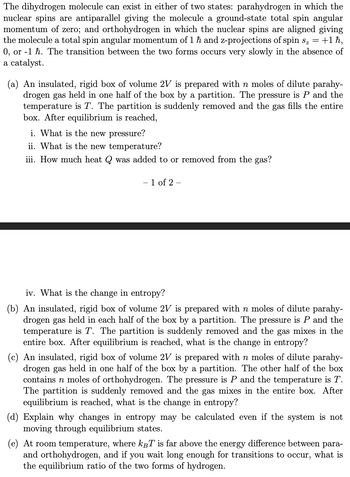Question
please show each part step by step

Transcribed Image Text:The dihydrogen molecule can exist in either of two states: parahydrogen in which the
nuclear spins are antiparallel giving the molecule a ground-state total spin angular
momentum of zero; and orthohydrogen in which the nuclear spins are aligned giving
the molecule a total spin angular momentum of 1 ħ and z-projections of spin s₂ = +1 ħ,
0, or 1 h. The transition between the two forms occurs very slowly in the absence of
a catalyst.
(a) An insulated, rigid box of volume 2V is prepared with n moles of dilute parahy-
drogen gas held in one half of the box by a partition. The pressure is P and the
temperature is T. The partition is suddenly removed and the gas fills the entire
box. After equilibrium is reached,
i. What is the new pressure?
ii. What is the new temperature?
iii. How much heat Q was added to or removed from the gas?
- 1 of 2 -
iv. What is the change in entropy?
(b) An insulated, rigid box of volume 2V is prepared with n moles of dilute parahy-
drogen gas held in each half of the box by a partition. The pressure is P and the
temperature is T. The partition is suddenly removed and the gas mixes in the
entire box. After equilibrium is reached, what is the change in entropy?
(c) An insulated, rigid box of volume 2V is prepared with n moles of dilute parahy-
drogen gas held in one half of the box by a partition. The other half of the box
contains n moles of orthohydrogen. The pressure is P and the temperature is T.
The partition is suddenly removed and the gas mixes in the entire box. After
equilibrium is reached, what is the change in entropy?
(d) Explain why changes in entropy may be calculated even if the system is not
moving through equilibrium states.
(e) At room temperature, where kBT is far above the energy difference between para-
and orthohydrogen, and if you wait long enough for transitions to occur, what is
the equilibrium ratio of the two forms of hydrogen.
Expert Solution
This question has been solved!
Explore an expertly crafted, step-by-step solution for a thorough understanding of key concepts.
Step by stepSolved in 2 steps with 1 images

Knowledge Booster
Similar questions
arrow_back_ios
arrow_forward_ios